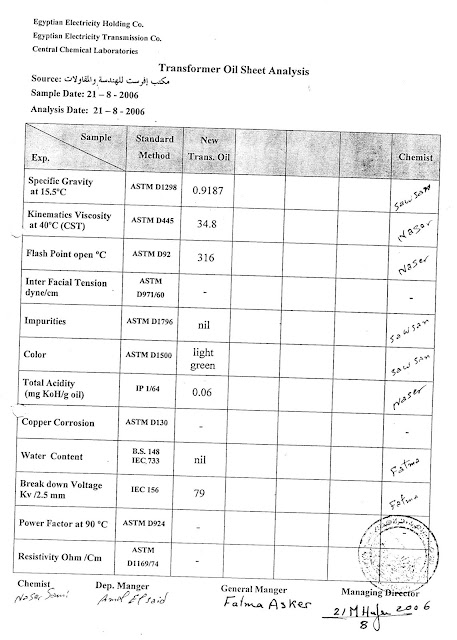Fire Safety & environmental & health of new oil
FIRE SAFETY
New oil has a fire point of 360ْْ C, Well above the NEC minimum of 300ْْ C. Its flash point (330ْْ C) is higher than the fire point of most other currently available less-flammable fluids.
New oil is certified as a less-flammable dielectric coolant by Factory Mutual and Underwriters Laboratories in compliance with the listing requirements of the NEC.
The National Fire Protection Association has no
reports of fires or explosions involving transformers filled with the New
oil.
In large and small-scale tests, New oil has demonstrated greater fire resistance than other askarel substitutes. Based on large-scale testing, Factory Mutual Research concluded that the probability of a pool fire evolving the New oil was so low, that it does not require heat release rate to be determined nor applied in determining the installation requirements of the oil.
Factory Mutual accepts New oil for transformers Approved per FM Standard 3990. OSHA has recognized this FM standard as fitting the definition of a Listed and Labeled product per NEC Section 110-3(b). The standard permits New oil filled transformers to be installed indoors, typically without sprinklers or vaults, with minimum clearance to walls of just 36 inches.
Underwriters Laboratories developed Standard 340 to compare the fire
hazard rating of different New oil. The following graph demonstrates the favorable
rating assigned to NEW OIL.
ENVIRONMENTAL & HEALTH
Envirotemp New oil is specifically
formulated to minimize health and environmental risk. It is made of food-grade
seed-oils and food grade performance enhancing additives. The base oils come
from renewable resources – commodity seeds – and are easily recyclable and
reusable. It does not require genetically altered seed oils. It has a trademark
green tint to help differentiate it from other dielectric fluids. Its
biodegradation rate is as good as the Environmental protection Agency®'s standard
reference material, deemed " ultimately biodegradable " per EPA.
Because New oil is formulated from food-grade oils and additives, it is not subject to the Federal Regulation of Used Oils ( Title 40, No. 270 ).
It is instead covered by the Edible Oil Regulatory Reform Act ( US Public Law 104-55, 1995), and therefore eligible for current and future regulatory relief.
The option of alternative spill response procedures, such as natural bio-remediation,
is now more viable. The New oil slightly higher viscosity when compared
to conventional transformer oil, combined with its ability to polymerize when
thin layers are exposed to warmth and airflow, helps prevent migration along
the surface and into subsurface soils.
New oil is not listed as hazardous by Environmental Protection Agency (EPA), Occupational Safety and Health Administration (OSHA) or the Department of Transportation (DOT
|
). Oral toxicity animal
tests reported no signs of toxicological reactions, nor have human contact
reactions have been reported.
New oil is not classified as bioaccumulating or mutagenic. It is a candidate
for classification as an "Environmentally Preferred Product". Its
Hazardous Material Information System (
HMIS ) rating is 0 for both health and reactivity, and negative for
carcinogenicity, National Toxicology Program (NTP), International Agency for
Research on Cancer (IARC) monographs and OSHA Regulation. The thermal decomposition
by-products from New oil are essentially limited to CO2 and H2O, with
trace CO depending on the availability
of oxygen and temperature. New oil can not produce PCDFs (Furans), PCDDs
(Dioxins), nor silicates.











No comments:
Post a Comment